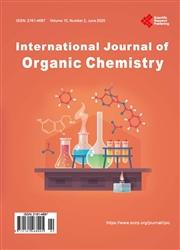Computational Study for the Aromatic Nucleophilic Substitution Reaction on 1-Dimethylamino-2,4-bis(trifluoroacetyl)-naphthalene with Amines
引用次数: 1
Abstract
Our previous research showed that aliphatic amines were put in order of high reactivity as “ethylamine > ammonia > t-butylamine > diethylamine” on the aromatic nucleophilic substitution of 1-dimetylamino-2,4-bis(trifluoroacetyl)-naphthalene 1 in acetonitrile. The DFT calculation study (B3LYP/6-31G* with solvation model) for the reactions of 1 with above four amines rationally explained the difference of each amines reactivity based on the energies of their Meisenheimer complexes 3 which are assumed to formed as the reaction intermediates in the course of the reaction giving the corresponding N-N exchange products 2. Intramolecular hydrogen bond between amino proton in 1-amino group and carbonyl oxygen in 2-trifluoroacetyl group stabilizes Meisenheimer complexes 3 effectively, and accelerates the substitution reaction from 1 to 2. Our calculation results also predicted that the above order of amines is also true if less polar toluene is used as a solvent instead of acetonitrile even though more enhanced conditions are required.1-二甲氨基-2,4-二(三氟乙酰基)-萘与胺的芳香亲核取代反应的计算研究
我们前期的研究表明,脂肪族胺在乙腈中亲核取代1-二甲胺-2,4-二(三氟乙酰基)-萘1的芳香族亲核取代上的高活性顺序为“乙胺>氨> t-丁胺>二乙胺”。1与上述四种胺的反应的DFT计算研究(B3LYP/6-31G*,溶剂化模型),根据假设在反应过程中形成的中间体Meisenheimer配合物3的能量,给出相应的N-N交换产物2,合理解释了每种胺的反应活性差异。1-氨基氨基质子与2-三氟乙酰基羰基氧之间的分子内氢键有效地稳定了Meisenheimer配合物3,加速了从1到2的取代反应。我们的计算结果还预测,如果使用较少极性的甲苯代替乙腈作为溶剂,即使需要更强的条件,上述胺的顺序也是正确的。
本文章由计算机程序翻译,如有差异,请以英文原文为准。
求助全文
约1分钟内获得全文
求助全文

 求助内容:
求助内容: 应助结果提醒方式:
应助结果提醒方式:


